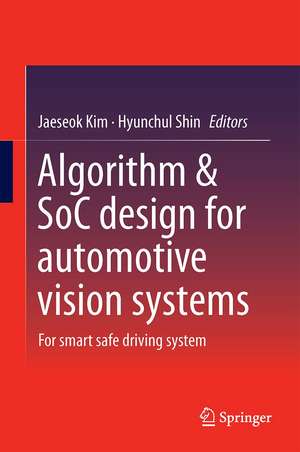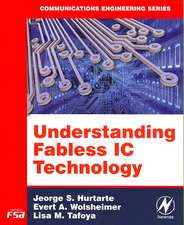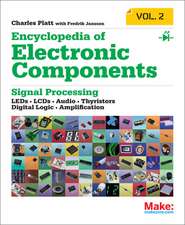Algorithm & SoC Design for Automotive Vision Systems: For Smart Safe Driving System
Editat de Jaeseok Kim, Hyunchul Shinen Limba Engleză Hardback – 18 iul 2014
Although radar-based systems are primarily used for sensing the driving environments, the camera has gained importance in advanced driver assistance systems (ADAS).
This book covers system-on-a-chip (SoC) designs—including both algorithms and hardware—related with image sensing and object detection by using the camera for smart driving systems. It introduces a variety of algorithms such as lens correction, super resolution, image enhancement and object detections from the images captured by low-cost vehicle camera. This is followed by implementation issues such as SoC architecture, hardware accelerator, software development environment and reliability techniques for automobile vision systems.
This book is aimed for the new and practicing engineers in automotive and chip-design industries to provide some overall guidelines for the development of automotive vision systems.
It will also help graduate students understand and get started for the research work in this field.
| Toate formatele și edițiile | Preț | Express |
|---|---|---|
| Paperback (1) | 640.71 lei 6-8 săpt. | |
| SPRINGER NETHERLANDS – 27 sep 2016 | 640.71 lei 6-8 săpt. | |
| Hardback (1) | 646.94 lei 6-8 săpt. | |
| SPRINGER NETHERLANDS – 18 iul 2014 | 646.94 lei 6-8 săpt. |
Preț: 646.94 lei
Preț vechi: 761.10 lei
-15% Nou
123.81€ • 128.78$ • 102.21£
Carte tipărită la comandă
Livrare economică 14-28 aprilie
Specificații
ISBN-10: 9401790744
Pagini: 300
Ilustrații: IX, 290 p. 247 illus., 2 illus. in color.
Dimensiuni: 155 x 235 x 25 mm
Greutate: 0.6 kg
Ediția:2014
Editura: SPRINGER NETHERLANDS
Colecția Springer
Locul publicării:Dordrecht, Netherlands
Public țintă
ResearchCuprins
Preface.
Chapter 1 Introduction; Jae-seok Kim, Hyun-chul Shin. 1.1 Introduction to the advanced driver assistance system. 1.2 Industrial Developments for ADAS. 1.3 System-on-chip platform architecture for automobile vision systems. References.
Chapter 2 Lens Correction and Gamma Correction; Sang-Bock Cho. 2.1 Lens Correction. 2.2 Gamma Correction. References.
Chapter 3 Super Resolution; Hyo-Moon Cho. 3.1 Introduction. 3.2 Observation model. 3.3 Survey of the Super Resolution algorithms. 3.4 Novel Super Resolution registration algorithm based on Frequency. 3.5 Conclusion. References.
Chapter 4 Image enhancement for improving object recognition; Jae-Seok Kim. 4.1 General Image Enhancement Techniques. 4.2 Image Enhancement Techniques for Automobile Application. References.
Chapter 5 Detection of Vehicles and Pedestrians; Hyunchul Shin, Irfan Riaz. 5.1 Introduction to Vehicle/Pedestrian Detection. 5.2 Vehicle Detection. 5.3 Pedestrian Detection. 5.4 Night-time Pedestrian Detection. References.
Chapter 6 Monitoring Driver’s State and Predicting Unsafe Driving Behavior; Hang-Bong Kang. 6.1 Introduction. 6.2 Driver Drowsiness Measurement. 6.3. Driver Distraction Detection. 6.4 Predicting Unsafe Driving Behavior. 6.5 Discussion. 6.6 Conclusions. References
Chapter 7 SoC Architecture for Automobile Vision System; Kyounghoon Kim, Kiyoung Choi. 7.1 Automotive Applications. 7.2 Architectural Consideration for Vision. 7.3 Example - Pedestrian Detection. 7.4 Comparison of COTS Architectures. 7.5 More on GPU. 7.6 Comparison of VLIW and COTS Architecture. 7.7 Memory/Bus Requirement. 7.8 Vision Processors. 7.9 Yet another Approach. 7.10 Conclusions. References.
Chapter 8 Hardware accelerator for feature point detection and Matching; Jun-Seok Park, Lee-Sup Kim. 8.1. Introduction to interest point detection and matching. 8.2. Interest point detection hardware with joint algorithm-architecture optimization. 8.3. Unified Datapath. 8.4. Chip implementation. 8.5. Application. 8.6. Conclusions. References.
Chapter 9 Software Development Environment for Automotive SoC; Jeonghun Cho. 9.1. Introduction. 9.2. AUTOSAR architecture. 9.3. Demonstration of AUTOSAR ECUs. 9.4. Conclusions. References.
Chapter 10 Reliability issues for automobile SoCs; Sungju Park. 10.1 Introduction. 10.2 Conclusions. References.
Notă biografică
Prof. Jaeseok Kim received B.S degree from Yonsei University in Korea, M.S degree from KAIST in Korea and Ph. D degree from RPI, USA in 1988. From 1988 to 1993, he was a member of technical staff at the AT&T Bell Lab., Murray Hill, NJ, USA. He is currently a professor of the electrical and electronic engineering department at Yonsei University, Seoul, Korea.
He was the best research achievement professor of year 2006 at Yonsei University and received the best brain award in Korea semiconductor technology area in 2005.
He has published more than a hundred refereed papers with five text books in electrical engineering area. He holds 45 patents and transferred 5 patents to ten companies.
He is now serving as a distinguished lecturer of IEEE Circuit & System society. His current research interests include wireless communication SoC design, high performance video codec and image signal processing algorithm and SoC platform architecture.
Prof. Hyunchul Shin received B.S. degree and M.S. degree, from SNU and KAIST, respectively and Ph. D degree from U.C. Berkeley in 1987. He received Fulbright Scholarship. From 1987 to 1989, he was a member of technical staff at the AT&T Bell Lab., Murray Hill, NJ, USA. Since 1989, he has been a professor of the Department of Electronics Engineering at Hanyang University, Ansan, Korea. He has published more than a hundred technical papers and holds 15 patents. He worked as a Technical Adviser for several companies, including Samsung Electronics Co. and Atrenta. He served as General Chair of ISOCC 2007 and as Program Chair of ASP-DAC 2011. He is the president of IDEC Platform Center at Hanyang University. His research interests include SoC design, Computer Aided Design and Design and Synthesis of Integrated Systems for Vision and Image Processing applications.
Textul de pe ultima copertă
An emerging trend in the automobile industry is its convergence with information technology (IT). Indeed, it has been estimated that almost 90% of new automobile technologies involve IT in some form. Smart driving technologies that improve safety as well as green fuel technologies are quite representative of the convergence between IT and automobiles. The smart driving technologies include three key elements: sensing of driving environments, detection of objects and potential hazards, and the generation of driving control signals including warning signals.
Although radar-based systems are primarily used for sensing the driving environments, the camera has gained importance in advanced driver assistance systems(ADAS).
This book covers system-on-a-chip (SoC) designs including both algorithms and hardware related with image sensing and object detection by using the camera for smart driving systems. It introduces a variety of algorithms such as lens correction, super resolution, image enhancement, and object detections from the images captured by low-cost vehicle camera. This is followed by implementation issues such as SoC architecture, hardware accelerator, software development environment, and reliability techniques for automobile vision systems.
This book is aimed for the new and practicing engineers in automotive and chip-design industries to provide some overall guidelines for the development of automotive vision systems.
It will also help graduate students understand and get started for the research work in this field.
"
Caracteristici
Introduces a variety of vision-related algorithms and SoC implementation issues
Provides a guideline to get started for R&D works in automotive vision systems
Both software and hardware aspects of system-on-a-chip (SoC) platform architectures are presented in one book, this is unique
Descriere
An emerging trend in the automobile industry is its convergence with information technology (IT). Indeed, it has been estimated that almost 90% of new automobile technologies involve IT in some form. Smart driving technologies that improve safety as well as green fuel technologies are quite representative of the convergence between IT and automobiles. The smart driving technologies include three key elements: sensing of driving environments, detection of objects and potential hazards and the generation of driving control signals including warning signals.
Although radar-based systems are primarily used for sensing the driving environments, the camera has gained importance in advanced driver assistance systems (ADAS).
This book covers system-on-a-chip (SoC) designs—including both algorithms and hardware—related with image sensing and object detection by using the camera for smart driving systems. It introduces a variety of algorithms such as lens correction, super resolution, image enhancement and object detections from the images captured by low-cost vehicle camera. This is followed by implementation issues such as SoC architecture, hardware accelerator, software development environment and reliability techniques for automobile vision systems.
This book is aimed for the new and practicing engineers in automotive and chip-design industries to provide some overall guidelines for the development of automotive vision systems.
It will also help graduate students understand and get started for the research work in this field.















